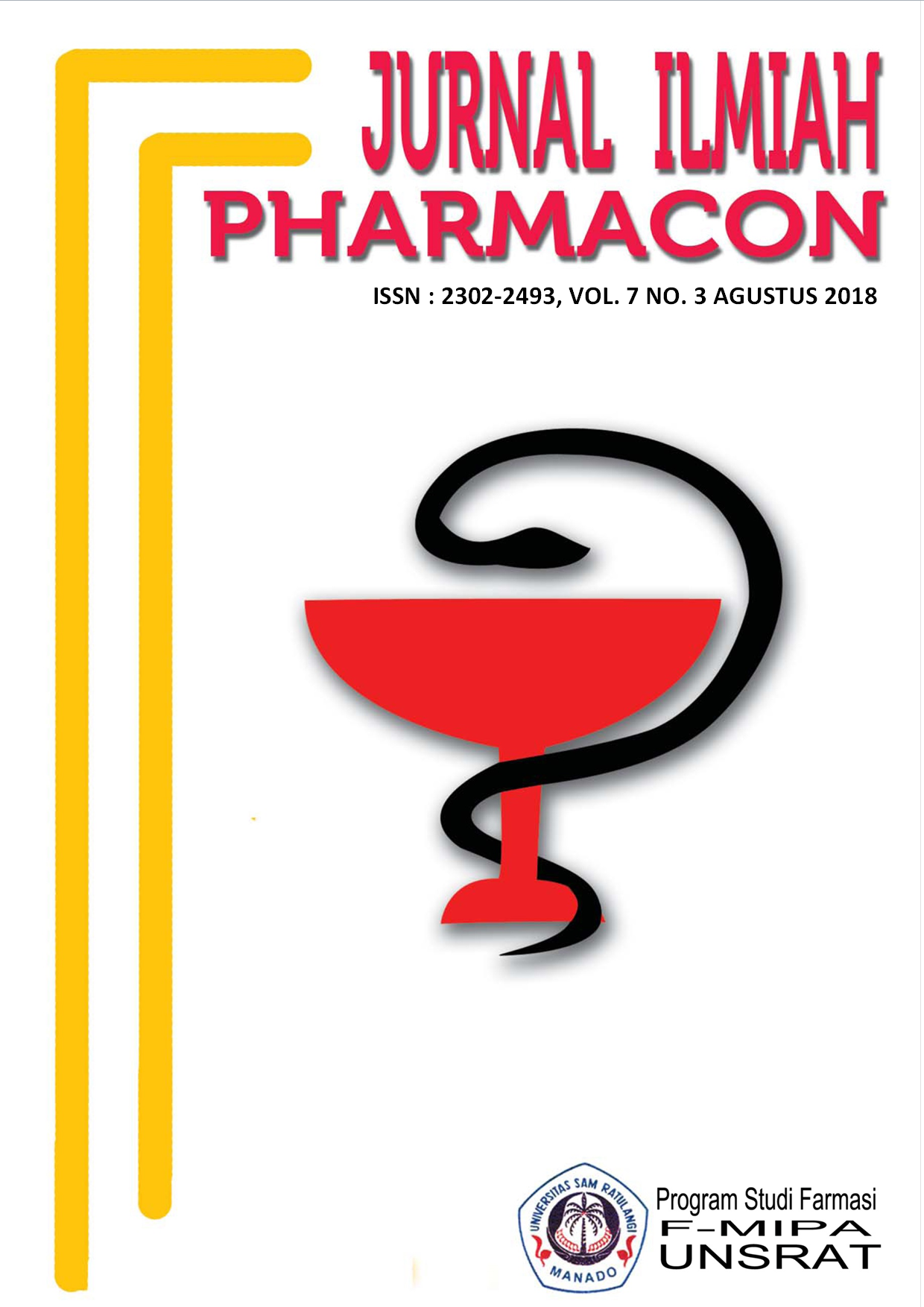FORMULASI SEDIAAN GEL ANTIBAKTERI EKSTRAK ETANOL TANAMAN SEREH (Cymbopogon citratus (DC.) Stapf) DAN UJI AKTIVITAS ANTIBAKTERI (Staphylococcus aureus) SECARA in vitro
DOI:
https://doi.org/10.35799/pha.7.2018.20571Abstract
FORMULASI SEDIAAN GEL ANTIBAKTERI EKSTRAK ETANOL TANAMAN SEREH (Cymbopogon citratus (DC.) Stapf) DAN UJI AKTIVITAS ANTIBAKTERI (Staphylococcus aureus) SECARA in vitro
Bryce Maria Brigitha Sikawin1), Paulina V.Y. Yamlean1), Sri Sudewi1)
1)Program Studi Farmasi FMIPA UNSRAT Manado, 95115
ABSTRACT
Antibacterial is a compound used to control the growth of harmful bacteria. Control of the growth of microorganisms aims to prevent the spread of disease and infection. Citronella (Cymbopogon citratus (D.C) Stapf) contains sitronellal and geraniol compounds that are known to be antibacterial. The objective of this research was to make an antibacterial gel formulation of citronella extract with three variations of extract concentration, ie 0.5%, 1.0% and 1.5%, and to test their antibacterial activity against Staphylococcus aureus bacteria. Citronella plant (Cymbopogon citratus (D.C) Stapf) extract was obtained by maceration using 96% ethanol as the solvent. The results showed that citronella extract can be formulated as antibacterial gel that meets organoleptic, homogeneity, pH, dispersion, and adhesion requirements. In the test results of antibacterial activity, there are clear zones that represent the inhibitory capability of bacterial growth by the gels. The mean diameter of the clear zones of the citronella plant extract at concentrations of 0.5%, 1% and 1.5% were 18.18 mm, 20.56 mm and 22.80 mm, respectively. Based on the classification of antibacterial power strength, the ability of inhibition of bacteria by 0.5% and 1% concentration gels are categorized as strong, and 1.5% is the best gel inhibiting the activity of S. aureus bacteria with 22.80 mm inhibited zone diameter that is categorized very strong.
Keywords: Citron, Gel, Staphylococcus aureus, HPMC.
ABSTRAK
Antibakteri ialah senyawa yang digunakan untuk mengendalikan pertumbuhan bakteri yang bersifat merugikan. Pengendalian pertumbuhan mikroorganisme bertujuan untuk mencegah penyebaran penyakit dan infeksi. Tanaman sereh (Cymbopogon citratus (D.C) Stapf) mengandung senyawa sitronellal dan geraniol yang diketahui dapat bersifat antibakteri. Penelitian ini bertujuan untuk membuat formulasi sediaan gel antibakteri dari ekstrak tanaman sereh dengan tiga variasi konsentrasi ekstrak yakni 0,5 %, 1,0% dan 1,5%, serta menguji aktivitas antibakterinya terhadap bakteri Staphylococcus aureus. Ekstrak tanaman sereh (Cymbopogon citratus (D.C) Stapf) diperoleh dengan cara maserasi menggunakan pelarut etanol 96%. Hasil penelitian menunjukkan bahwa ekstrak tanaman sereh dapat diformulasikan sebagai sediaan gel antibakteri yang memenuhi persyaratan organoleptik, homogenitas, pH, daya sebar, dan daya lekat. Pada hasil pengujian aktivitas antibakteri, terdapat zona bening yang merepresentasikan kemampuan penghambatan pertumbuhan bakteri uji oleh gel. Diameter rata-rata zona bening sediaan gel ekstrak tanaman sereh pada konsentrasi 0,5 %, 1,0% dan 1,5 % berturut-turut yaitu 18,18 mm, 20,56 mm dan 22,80 mm. Berdasarkan klasifikasi kekuatan daya antibakteri, maka kemampuan penghambatan bakteri uji oleh gel konsentrasi 0,5% dan 1% dikategorikan kuat, serta 1,5% merupakan gel yang paling baik menghambat aktivitas bakteri S. aureus dengan diameter zona hambat 22,80 mm yang dikategorikan sangat kuat.
Kata kunci: Sereh, Gel, Staphylococcus aureus, HPMC
Downloads
Published
How to Cite
Issue
Section
License
Authors who publish with this journal agree to the following terms:
- Authors retain copyright and grant the journal right of first publication with the work simultaneously licensed under a Creative Commons Attribution-NonCommercial 4.0 International License that allows others to share the work with an acknowledgement of the work's authorship and initial publication in this journal.
- Authors are permitted and encouraged to post their work online (e.g., in institutional repositories or on their website) prior to and during the submission process, as it can lead to productive exchanges, as well as earlier and greater citation of published work (See The Effect of Open Access)










